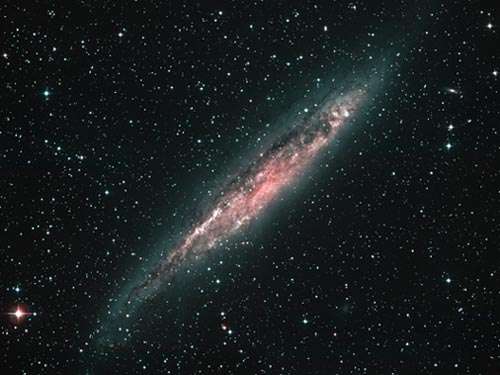A new paradigm for active galactic nuclei

(Phys.org) -- Seyfert galaxies are similar to normal galaxies like our own Milky Way except in one critical respect: their nuclei are fantastically bright, in extreme instances as luminous as 100 billion suns. Astronomers think that these huge energies are generated in such active galactic nuclei by processes around their massive black holes. Matter, as it falls in towards the vicinity of a black hole, heats up and radiates intensely. The Milky Way also has a massive black hole at its center, and there is evidence that some matter is falling in towards it, but for reasons that are not understood the center of our galaxy is not particularly bright as compared to its star-filled spiral arms.
Optical observations find two morphological types of Seyfert galaxies: some with bright spectral lines from excited atoms moving at high velocities, and others lacking this characteristic radiation. The most popular explanation has been that both kinds of objects are intrinsically the same, both with active accretion underway, but in the latter cases a torus (or disk) of dust around the nuclei obscures the light from those atoms when the galaxy happens to be seen edgewise from the Earth. In this interpretation, the different kinds of Seyfert galaxies are simply a reflection of their different orientations in the sky. This idea simplifies the overall scheme of galaxy types.
This model received strong support when astronomers were able to spot faint hints of that characteristic radiation in some edge-on galaxies, the implication being that radiation from a hidden but active region had leaked out the poles of the obscuring torus and was scattered towards us. The problem has been that more sensitive observations have now probed a larger sample of Seyferts, and found that many of them do not fit into either of these two categories. In fact, only about half of the bright, nominally edge-on Seyferts show any evidence of scattered radiation from an obscured, inner region. As a result, for about ten years scientists have been gathering evidence that something other than geometry is responsible for the difference between these galaxies.
CfA astronomers Andrea Marinucci, Fabrizio Nicastro, and Andy Goulding, with two colleagues, have published a new paper arguing that indeed something else is probably going on, and the standard paradigm needs fixing. They prepared a comparatively large sample of thirty-nine Seyferts thought to be edge-on, and for which a wide range of data were available. The sample consisted of two groups, one composed of the half of the sources showing evidence for faint, scattered nuclear radiation, and the other one with the half showing no such evidence. The scientists compared the sample's X-ray and optical data, the inferred masses of their black holes, and their luminosities.
The team found that the two groups of galaxies, as groups, had consistently different characteristics. Active accretion was underway only in the set showing the faint characteristic radiation; the other set lacked this scattered light not because the torus was opaque, but because there was little or no activity underway as evidenced by their lower luminosities as well as some other features. These conclusions need to be confirmed with larger samples, but the results suggest that details of accretion mechanism(s) need to be included in the categorization of Seyfert galaxies, and perhaps also of other galaxies with activity around their nuclear black holes.
Provided by Harvard-Smithsonian Center for Astrophysics










.jpg)










